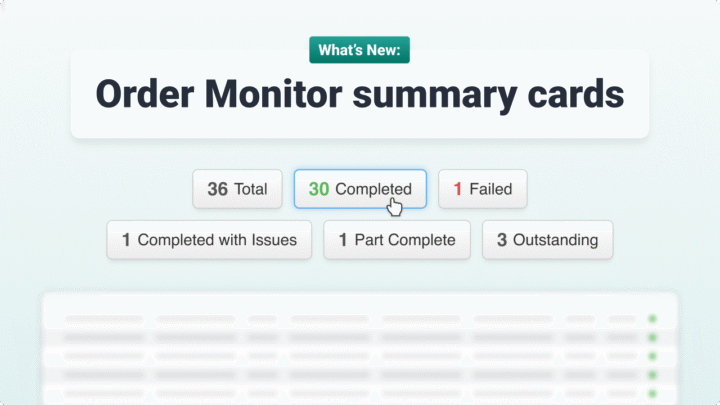Over the past decade, technological advancements of Transport Management Systems and the features and functionality they offer have galvanised logistics operations and supply chains, leading businesses across a broad range of industries to invest in the solution to streamline their operations.
The market continues to become increasingly saturated with all-in-one transport and delivery management platforms that include core features that optimise routes, automate route planning, and capture electronic Proof of Delivery (ePOD), and offer a range of business-boosting benefits.
The sheer number of options available to businesses can make it challenging to choose the right one.
For transport operations of numerous sizes, SmartRoutes has emerged as one such player in the Transport Management System space.
In this post, we’re going to explore some of the platform’s key features, as well as its pricing structure, and compare it to an alternative, market-leading solution in Stream, offering an overview of two key players in the field.
What is a Transport Management System?
First and foremost, it helps if there’s a good understanding of what a Transport Management System is and the benefits on offer before looking to invest in one.
A Transport Management System (often abbreviated to TMS) is an essential part of supply chain logistics that offers a range of functionality to help companies move goods from origin to destination as efficiently as possible in order to reduce costs, boost customer service, and improve sustainability initiatives.
It addresses a number of challenges presented across the supply chain involved with transportation, deliveries, and collections, particularly throughout the last mile. Challenges associated with vehicle capacity, inefficient routing and route management, delivery visibility and traceability, driver and vehicle management, and overall performance across the supply chain are addressed.
Both Stream and SmartRoutes offer solutions to these core challenges (and more) through software features that have their nuances in comparison. These features are accessible through a subscription pricing structure that generally scales with the size of your operation.
It’s all about understanding the needs of your operation and your operation’s size, and which system best fulfils your operation’s needs within budget.
Pricing: which offers more mileage for your buck?
Stream and SmartRoutes use a similar pricing structure, which includes three core tiers, each at increasing price points that give you access to specific features and functionality. The more you pay per month, the more features and vehicles you gain access to. It’s advised that you have a clear look at which features are included in which tier and to decide whether or not they solve the challenges your operation is looking to address.
The prices for the three tiers are each displayed per vehicle, with Stream including three vehicles per tier as standard, with the option to add more to the already included vehicles (if necessary) at a discounted price.
SmartRoute’s pricing structure is displayed per single vehicle. The average fleet size in the UK is 5 vehicles, which will be used as a reference for context. Generally, the lower subscription tiers are better suited for smaller businesses and operations with fewer vehicles and staff, that will only use a limited amount of the features and functionality the platforms have to offer.
Both have transparent monthly and annual price options for each tier, with Stream offering the option to customise plans further by adding additional features in the form of add-ons to each subscription, such as a HGV and commercial vehicle-specific navigation app and mobile delivery forms, an option that SmartRoutes currently does not offer outside of a customisable questionnaire for drivers before they begin their route called ‘Vehicle Check’. Stream offers a similar add-on under Stream Check, which helps operations eliminate paper, and manage vehicle walkaround checks and defect reporting processes digitally.
Let’s take an in-depth look at Stream’s and SmartRoutes’ respective pricing tiers and the functionality that is included in each.
SmartRoutes’ pricing
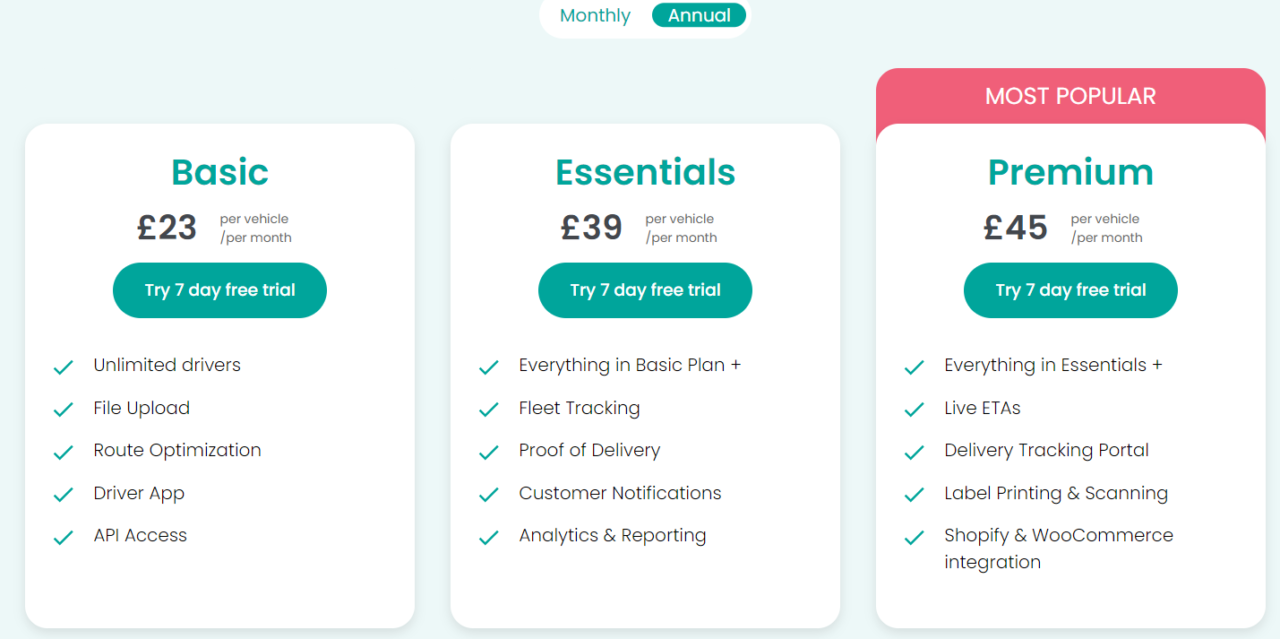
SmartRoutes offer a clear pricing structure at very accessible prices, starting from £23 per month, per vehicle. Their Basic package, similarly to Stream, includes a range of entry-level features, both without email support included, so they are self-service software at this entry point with supporting documentation used as a guide to learn and navigate.
This makes it a good entry point for small-scale businesses and fleets.
Using the UK average fleet size of five vehicles, the entry level Basic tier costs £115 annually, the mid-level Essential tier costs £195 annually, and the Premium tier costs £225.
Key ecommerce integrations, Shopify, Woocommerce, and Mintsoft are only available on their Premium subscription tier. SmartRoutes also have an open API available for each subscription tier, so integrations with the software can be built where required.
Stream’s pricing
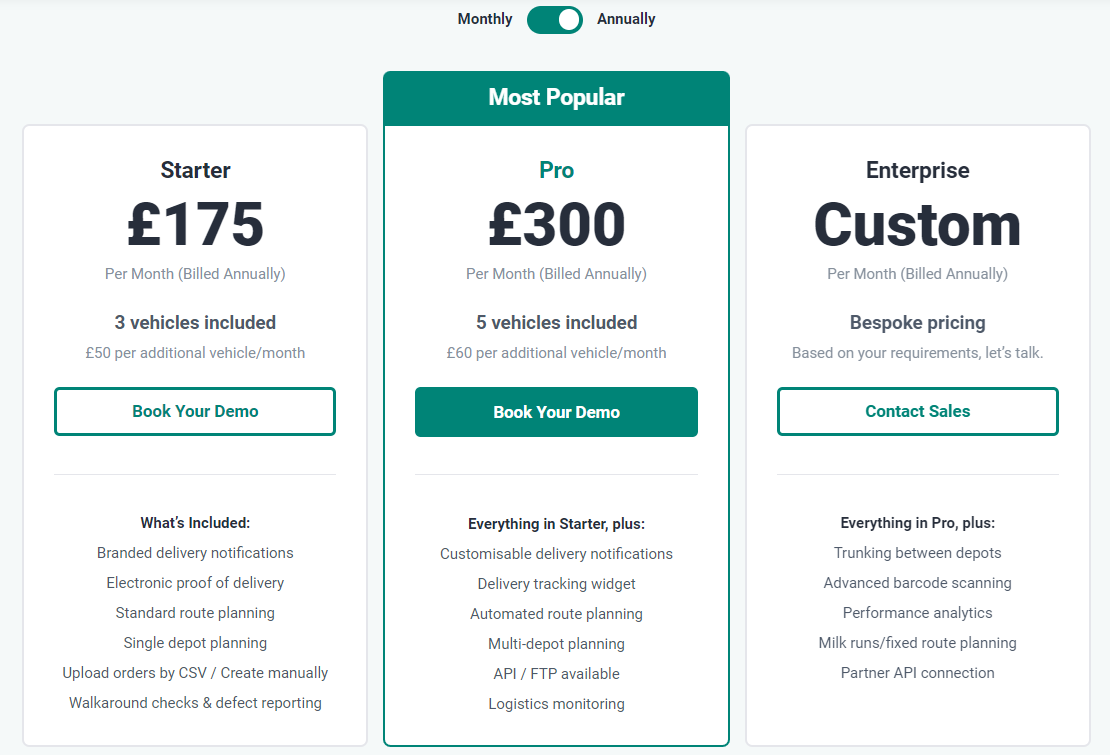
Stream’s basic package starts from £175 annually and includes three vehicles, with a further discount per vehicle if additional vehicles are added beyond the three included.
Using the UK average fleet size of five vehicles, the entry level Starter tier costs £275 annually, the mid-level Pro tier costs £300 annually, and the Enterprise tier’s pricing is bespoke, varying depending on fleet size and the additional functionality and add-ons that are required.
Features
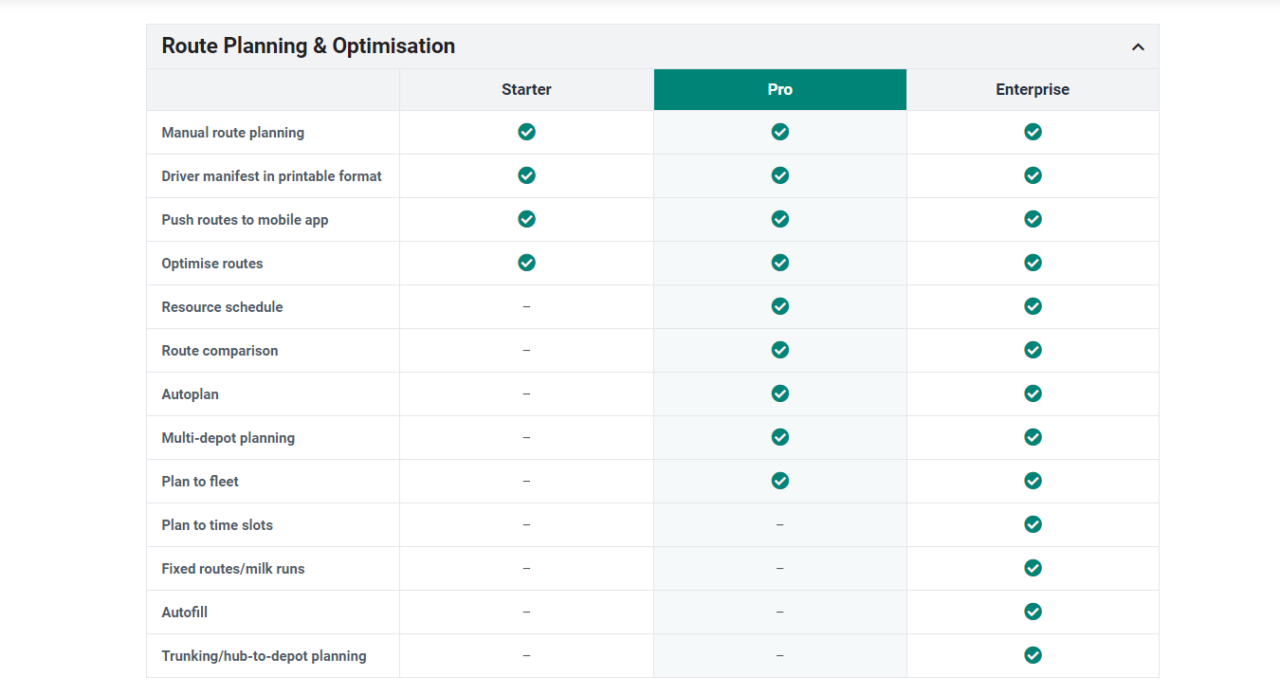
Stream’s features and subfeatures are listed in significant detail on their feature pages and pricing page, breaking down each core feature with the functionality available within it (subfeature). The pricing page offers a quick snapshot of everything included per tier at a glance, with detailed information available on their respective feature page.

SmartRoutes’ pricing page, however, only references which feature is included per tier without a breakdown of the subfeatures included in each. There is an information button that users can hover over to get a quick overview and context about what the subfeature is. Here Stream offers a much clearer overview of every subfeature included within their core features in comparison.
Now, into the nitty-gritty, looking at the core features and subfeatures each platform has to offer, highlighting the key differences between the two to see if Stream merits the higher price point per tier.
Key feature differences
Route Optimisation
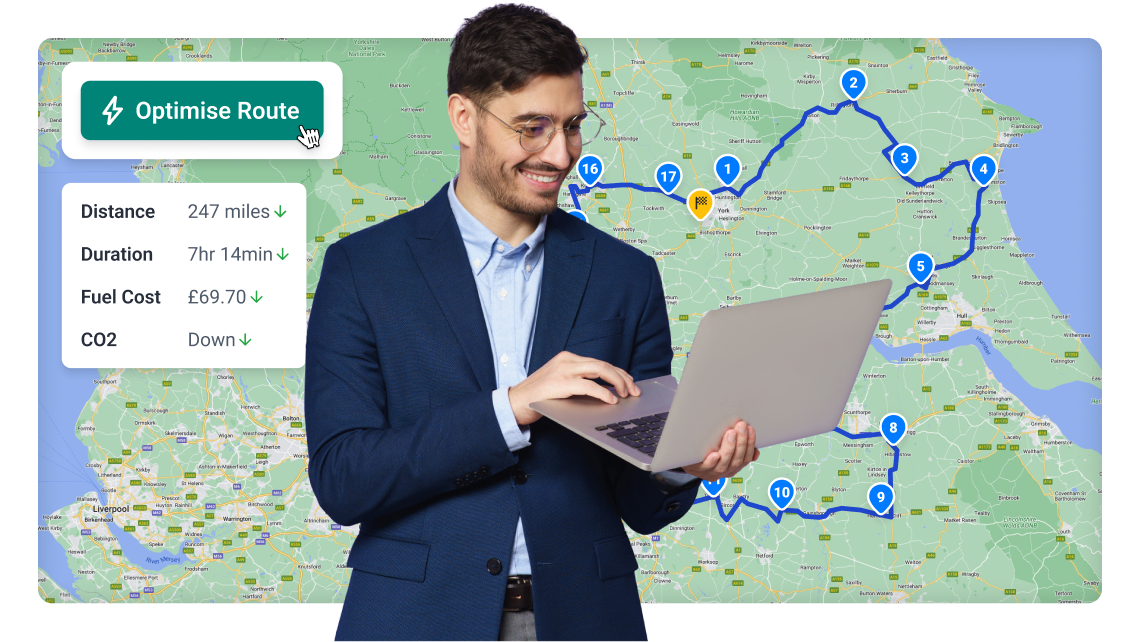
Stream has a number of notable Route Optimisation subfeatures that distinguish it from SmartRoutes. Stream offers the ability to:
- Add driver breaks
Add designated driver breaks to the run automatically, as you optimise your routes. - Utilise multi-depot optimisation
Optimise delivery & collection routes for orders specific to each of your individual depots. - Load planning
Ensure you get the most on each vehicle in the planning process by taking product weight & dimensions into account.
Route Planning
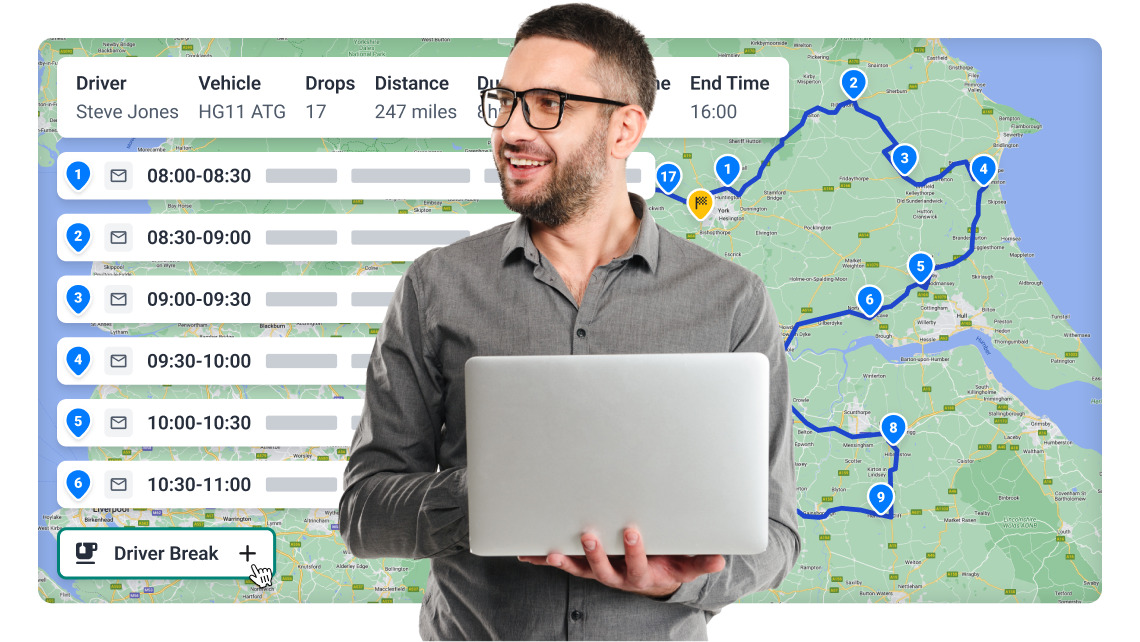
Stream also has a number of Route Planning subfeatures that SmartRoutes currently do not offer, which seems to be a general theme throughout. The software provides a deeper level of functionality to tackle a broader range of logistical challenges, including:
- Map drawing tool
Draw around a selection of orders on the map to easily group and select them based on location. - Multi-depot planning
Plan delivery & collection routes for orders specific to each of your individual depots. - ‘Milk runs’ & fixed routes (Enterprise tier only)
Create templated fixed routes/milk runs to produce recurring runs, over and over again. - Add driver breaks
Add automatic, or manual, driver breaks to runs to provide designated break times for drivers. - Compare planned routes
Compare multiple planned routes using Route Comparison to identify inefficiencies or crossover.
Walkaround Checks
There’s no clear mention of what SmartRoute’s Vehicle Check offering includes in detail, outside of the description that it’s a questionnaire, and there’s no clear pricing on it. Stream’s vehicle safety and maintenance features, such as Walkaround Checks and Vehicle Management, are included in each tier, giving you access to a number of functionalities to help you manage and maintain your vehicles, notably:
- Complete vehicle checks
Drivers work through a list of checks using Stream’s mobile app. - Check history logged against each vehicle
Keep a full audit history of all completed checks for your whole fleet. - Customise your checks
Use our default checks or customise them as you want. - Create your own checks
Create your own individual checks to meet your requirements. - Create check types
Operate a mixed fleet? Create checks specific to each type of vehicle (or asset). - Check anything, not just vehicles!
Don’t limit your checks to HGVs, vans, or coaches. Check anything, from trailers and equipment to PPE. - Record details of accidents
Create custom accident checks to record all the necessary information from an accident. - Access vehicle checks at the roadside
Need to show proof of completed vehicle checks at the roadside? The Steam app stores the last 10 checks on the device even offline.
HGV-specific Navigation (add-on)
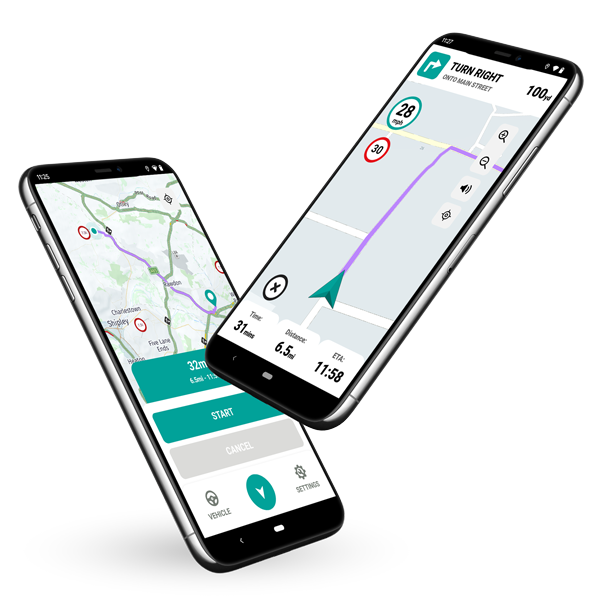
Stream offers a commercial vehicle navigation application (priced per driver) for safe and compliant navigation for a range of commercial vehicles, which can be downloaded from the Google Play store for Android. It’s a distinguishing feature for Stream and a feature that few Transport Management Systems on the market offer, so here’s insight into its core functionality:
- Truck/HGV/commercial vehicle routing & alerts
Truck, HGV, & commercial vehicle-specific routing ensures only suitable routes are taken. - Real-time traffic updates
Real-time traffic information displays in the navigation view, and alternate, more efficient routes will be offered where possible. - Stream integration
Destination addresses & vehicle limitations are automatically pulled from Stream to enable swift 2-tap navigation. - Speed alerts
Visual & audio speeding alerts further enhance driver safety.
Integrations
SmartRoutes and Stream offer a number of integrations with a host of popular softwares and backend systems, from ERPs to accounting softwares, so that you can conveniently plan your orders for delivery or plan collections processed elsewhere. The list of compatible integrations differs slightly, so here’s a snapshot of the integrations they’re compatible with to see if they plug in with your current system.
Both also have an API to build your own integration at an additional cost.
SmartRoutes Integrations
Stream Integrations
The verdict
In conclusion, both platforms offer solutions to core challenges faced by transportation operations, such as vehicle capacity, inefficient routing, delivery visibility, and driver and vehicle management. However, they differ in terms of pricing, features, and functionality.
Stream’s pricing structure starts at a higher level but offers a wider range of features, including multi-depot optimisation, load planning, and a commercial vehicle navigation app. SmartRoutes, on the other hand, has a more affordable pricing structure but may lack some of the advanced features offered by Stream.
The best choice for your operation depends on your specific needs and budget. By carefully considering the features and pricing of both platforms, you can select the TMS that best suits your business and helps you streamline your logistics operation.
Looking for a smarter route planning alternative to SmartRoutes?
If you’re interested in streamlining your delivery operation and boosting your delivery success rate, feel free to book a demo with one of our experts so we can understand your needs and give you a comprehensive overview of the platform.

